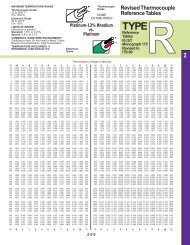Using Thermocouples
Using Thermocouples
Using Thermocouples
Create successful ePaper yourself
Turn your PDF publications into a flip-book with our unique Google optimized e-Paper software.
Poor Junction Connection<br />
There are a number of acceptable ways to connect<br />
two thermocouple wires: soldering, silver-soldering,<br />
welding, etc. When the thermocouple wires are<br />
soldered together, we introduce a third metal into the<br />
thermocouple circuit, but as long as the temperatures<br />
on both sides of the thermocouple are the same, the<br />
solder should not introduce any error. The solder does<br />
limit the maximum temperature to which we can subject<br />
this junction. To reach a higher measurement<br />
temperature, the joint must be welded. But welding is<br />
not a process to be taken lightly. 3 Overheating can<br />
degrade the wire, and the welding gas and the<br />
atmosphere in which the wire is welded can both diffuse<br />
into the thermocouple metal, changing its<br />
characteristics. The difficulty is compounded by the very<br />
different nature of the two metals being joined.<br />
Commercial thermocouples are welded on expensive<br />
machinery using a capacitive-discharge technique to<br />
insure uniformity.<br />
Fe<br />
C<br />
Junction: Fe - Pb, Sn - C = Fe - C<br />
A poor weld can, of course, result in an open<br />
connection, which can be detected in a measurement<br />
situation by performing an open thermocouple check.<br />
This is a common test function available with<br />
dataloggers. While the open thermocouple is the<br />
easiest malfunction to detect, it is not necessarily the<br />
most common mode of failure.<br />
Decalibration<br />
Decalibration is a far more serious fault condition than<br />
the open thermocouple because it can result in a<br />
temperature reading that appears to be correct.<br />
Decalibration describes the process of unintentionally<br />
altering the physical makeup of the thermocouple wire<br />
so that it no longer conforms to the NBS polynomial<br />
within specified limits. Decalibration can result from<br />
diffusion of atmospheric particles into the metal caused<br />
by temperature extremes. It can be caused by high<br />
temperature annealing or by cold-working the metal, an<br />
effect that can occur when the wire is drawn through a<br />
conduit or strained by rough handling or vibration.<br />
Annealing can occur within the section of wire that<br />
undergoes a temperature gradient.<br />
3 Refer to Bibliography 5<br />
4 Refer to Bibliography 9<br />
5 Refer to Bibliography 7<br />
SOLDERING A THERMOCOUPLE<br />
Figure 25<br />
Solder (Pb, Sn)<br />
Robert Moffat in his Gradient Approach to<br />
Thermocouple Thermometry explains that the<br />
thermocouple voltage is actually generated by the<br />
section of wire that contains the temperature gradient,<br />
and not necessarily by the junction. 4 For example, if we<br />
have a thermal probe located in a molten metal bath,<br />
there will be two regions that are virtually isothermal<br />
and one that has a large gradient.<br />
In Figure 26, the thermocouple junction will not<br />
produce any part of the output voltage. The shaded<br />
section will be the one producing virtually the entire<br />
thermocouple output voltage. If, due to aging or<br />
annealing, the output of this thermocouple were found<br />
25˚C<br />
100˚C<br />
500˚C<br />
Metal Bath<br />
200<br />
300<br />
400<br />
500<br />
GRADIENT PRODUCES VOLTAGE<br />
Figure 26<br />
to be drifting, then replacing the thermocouple junction<br />
alone would not solve the problem. We would have to<br />
replace the entire shaded section, since it is the source<br />
of the thermocouple voltage.<br />
Thermocouple wire obviously can’t be manufactured<br />
perfectly; there will be some defects which will cause<br />
output voltage errors. These inhomogeneities can be<br />
especially disruptive if they occur in a region of steep<br />
temperature gradient. Since we don’t know where an<br />
imperfection will occur within a wire, the best thing we<br />
can do is to avoid creating a steep gradient. Gradients<br />
can be reduced by using metallic sleeving or by careful<br />
placement of the thermocouple wire.<br />
Shunt Impedance<br />
High temperatures can also take their toll on<br />
thermocouple wire insulators. Insulation resistance<br />
decreases exponentially with increasing temperature,<br />
even to the point that it creates a virtual junction. 5<br />
Assume we have a completely open thermocouple<br />
operating at a high temperature.<br />
The leakage Resistance, R L , can be sufficiently low to<br />
complete the circuit path and give us an improper<br />
voltage reading. Now let’s assume the thermocouple is<br />
not open, but we are using a very long section of small<br />
diameter wire.<br />
Z-29














